Best Text to Speech Software
Finding the best Text to Speech Software for your business is now faster and easier! Compare prices, reviews, features, and get a free consultation to find the perfect software.



No Cost Personal Advisor
List of 20 Best Text To Speech Software
Emergents | 2024
Software by Synthesia Ltd
Synthesia is an AI marketing software that helps you create professional videos from text in over 50 languages. Synthesia is known for creating highly personalized videos that can be used for promotions, corporate communications, learning and development, and much more. Learn more about Synthesia
Explore various Synthesia features, compare the pricing plans, and unlock the potential of seamless operations by selecting the right software for your business.
Synthesia Caters to
- StartUps
- SMBs
- Agencies
- Enterprises
Contenders | 2024
Simplifying voice overs using AI
Murf AI is a simple DIY too that allows you to change your script or convert home-style voice recording into a studio-quality AI voice over for your videos, presentations, or just text-to-speech requirements. Read Murf AI Reviews
Explore various Murf AI features, compare the pricing plans, and unlock the potential of seamless operations by selecting the right software for your business.
Features
View all Murf AI Features- K-12
- Single Sign On
- Video Management
- Academic / Education
- Learning Paths
- Multi-user capable
- For Classroom
- PowerPoint Conversion
Pricing
Basic Monthly
$ 19
Single User
Pro Monthly
$ 45
Upto 3 Users
Murf AI Caters to
- StartUps
- SMBs
- Agencies
- Enterprises
Emergents | 2024
Software by IBM
IBM Watson Campaign Automation is a top enterprise search solution. This enterprise search engine software offers rapid customer engagement, improved conversions, campaign optimization, personalized search, mobile connectivity, and multi-channel search. Learn more about IBM Watson
Explore various IBM Watson features, compare the pricing plans, and unlock the potential of seamless operations by selecting the right software for your business.
Features
View all IBM Watson Features- Sales Intelligence
- Feedback Management
- Activity Tracking
- Knowledge Management
- Campaign Management
- Predictive Analytics
- Alerts/Notifications
- Segmentation
Pricing
Free
$ 0
Per Month
Plus
$ 30
Per Month
Professional
$ 80
Per Month
IBM Watson Caters to
- StartUps
- SMBs
- Agencies
- Enterprises
Contenders | 2024
Software by Microsoft Corporation
Well known ecommerce management platform served for thousands of E-commerce business management. Microsoft Azure helps you to transact more sales, meet customer demand, optimize supply chain etc. It carries out all what you need for customer satisfaction. Read Microsoft Azure Reviews
Explore various Microsoft Azure features, compare the pricing plans, and unlock the potential of seamless operations by selecting the right software for your business.
Features
View all Microsoft Azure Features- Order Management
- Mobile Friendly Store
- Customer Support
- Email Marketing / SMS Marketing
- Inventory Management
- POS invoicing
- SEO and Online Marketing
- Order Status / Tracking and History
Pricing
Free
$ 0
user/month/annual billing
Basic
$ 1
user/month/annual billing
Premium P1
$ 6
user/month/annual billing
Microsoft Azure Caters to
- StartUps
- SMBs
- Agencies
- Enterprises
Emergents | 2024
Software by NaturalReader
NaturalReader is a fully featured Text to Speech Software designed to serve Enterprises, SMEs and StartUps. NaturalReader provides end-to-end solutions designed for Web App and Android. This online Text to Speech system offers Text to Speech at one place. Learn more about NaturalReader
Explore various NaturalReader features, compare the pricing plans, and unlock the potential of seamless operations by selecting the right software for your business.
Features
View all NaturalReader Features- HD Voice Quality
- Text to Speech
- Mobile Access
- Activity Log
- Full Text Search
- Dashboards & Analytics
- Android & mobile support
- Voice Capture
Pricing
Free
$ 0
Forever
Personal
$ 100
One Time
Professional
$ 130
One Time
NaturalReader Caters to
- StartUps
- SMBs
- Agencies
- Enterprises
Emergents | 2024
Natural Human Text to Speech & Voiceover Platform
Human-like Text to Speech & Voiceover platform with 34 languages & 160+ voices. Clone custom voice for your corporate branding! Available as a web application or API for easy integration. Learn more about LOVO Studio
Explore various LOVO Studio features, compare the pricing plans, and unlock the potential of seamless operations by selecting the right software for your business.
Features
View all LOVO Studio Features- Chat / Messaging
- Chatbot
- AI / Machine Learning
- NLP
- Speech Synthesis
Pricing
Freelancer Monthly
$ 75
Per Month
Freelancer Yearly
$ 599
Per Year
Personal Monthly
$ 25
Per Month
LOVO Studio Caters to
- StartUps
- SMBs
- Agencies
- Enterprises
Contenders | 2024
Online Text to Speech Converter with 400 Voices
TexVoz is an online Text to Speech conversion software that offers natural voices to bring your content to life, for the creation of audiobooks, narrations, IVR, etc. Create audios with the best quality of voices. Read TexVoz Reviews
Explore various TexVoz features, compare the pricing plans, and unlock the potential of seamless operations by selecting the right software for your business.
Features
View all TexVoz Features- AI / Machine Learning
- Virtual Classroom
- Deep Learning
- Academic / Education
- Speech Synthesis
- Virtual Assistant
- Video Conferencing
Pricing
Plan Personal
$ 9
Per Month
Growth Plan
$ 59
Per Month
Commercial Plan
$ 89
Per Month
TexVoz Caters to
- StartUps
- SMBs
- Agencies
- Enterprises
Emergents | 2024
Software by VoiceOverMaker
VoiceOverMaker is a fully featured Text to Speech Software designed to serve Enterprises, SMEs and StartUps. VoiceOverMaker provides end-to-end solutions designed for Web App and Android. This online Text to Speech system offers Text to Speech at one place. Learn more about VoiceOverMaker
Explore various VoiceOverMaker features, compare the pricing plans, and unlock the potential of seamless operations by selecting the right software for your business.
Features
View all VoiceOverMaker Features- Activity Log
- Voice Capture
- Full Text Search
- HD Voice Quality
- Mobile Access
- Speech Recognition
- Help Desk
- Android & mobile support
Pricing
Standard
$ 10
Per Month
VoiceOverMaker Caters to
- StartUps
- SMBs
- Agencies
- Enterprises
Emergents | 2024
Software by WellSaid Labs, Inc
WellSaid is a fully featured Text to Speech Software designed to serve Enterprises, SMEs and StartUps. WellSaid provides end-to-end solutions designed for Web App and Android. This online Text to Speech system offers Text to Speech at one place. Learn more about WellSaid
Explore various WellSaid features, compare the pricing plans, and unlock the potential of seamless operations by selecting the right software for your business.
Features
View all WellSaid Features- Android & mobile support
- Text to Speech
- HD Voice Quality
- Help Desk
- Full Text Search
- Speech Recognition
- Activity Log
- Mobile Access
Pricing
Trial
$ 0
Per Month
Maker
$ 49
Per Month
Creative
$ 99
Per Month
WellSaid Caters to
- StartUps
- SMBs
- Agencies
- Enterprises
Emergents | 2024
Software by BeyondWords
BeyondWords is a fully featured Text to Speech Software designed to serve Enterprises, SMEs and StartUps. BeyondWords provides end-to-end solutions designed for Web App and Android. This online Text to Speech system offers Text to Speech at one place. Learn more about BeyondWords
Explore various BeyondWords features, compare the pricing plans, and unlock the potential of seamless operations by selecting the right software for your business.
Features
View all BeyondWords Features- Android & mobile support
- Full Text Search
- Mobile Access
- Voice Capture
- Speech Recognition
- Text to Speech
- HD Voice Quality
- Activity Log
Pricing
Pilot
$ 0
Per Month
Pro
$ 89
Per Month
BeyondWords Caters to
- StartUps
- SMBs
- Agencies
- Enterprises
Emergents | 2024
Software by The Seaplace Group, LLC
CreateAIvoiceovers is a fully featured Text to Speech Software designed to serve Enterprises, SMEs and StartUps. CreateAIvoiceovers provides end-to-end solutions designed for Web App and Android. This online Text to Speech system offers Text to Speech at one place. Learn more about CreateAIvoiceovers
Explore various CreateAIvoiceovers features, compare the pricing plans, and unlock the potential of seamless operations by selecting the right software for your business.
Features
View all CreateAIvoiceovers Features- Activity Log
- Help Desk
- Mobile Access
- Full Text Search
- HD Voice Quality
- Speech Recognition
- Text to Speech
- Dashboards & Analytics
Pricing
PRODUCER
$ 130
Per Month
ENTERPRISE
$ 264
Per Month
CreateAIvoiceovers Caters to
- StartUps
- SMBs
- Agencies
- Enterprises
Emergents | 2024
Software by Web Lite Solutions
Tuxpin is a fully featured Text to Speech Software designed to serve Enterprises, SMEs and StartUps. Tuxpin provides end-to-end solutions designed for Web App and Android. This online Text to Speech system offers Text to Speech at one place. Learn more about Tuxpin
Explore various Tuxpin features, compare the pricing plans, and unlock the potential of seamless operations by selecting the right software for your business.
Features
View all Tuxpin Features- Help Desk
- HD Voice Quality
- Full Text Search
- Android & mobile support
- Activity Log
- Speech Recognition
- Dropbox
- Voice Capture
Tuxpin Caters to
- StartUps
- SMBs
- Agencies
- Enterprises
Emergents | 2024
Software by Trancekode Infoway
Speechactors is a fully featured Text to Speech Software designed to serve Enterprises, SMEs and StartUps. Speechactors provides end-to-end solutions designed for Web App and Android. This online Text to Speech system offers Text to Speech at one place. Learn more about Speechactors
Explore various Speechactors features, compare the pricing plans, and unlock the potential of seamless operations by selecting the right software for your business.
Features
View all Speechactors Features- Activity Log
- Android & mobile support
- Speech Recognition
- HD Voice Quality
- Voice Capture
- Full Text Search
- Text to Speech
- Help Desk
Pricing
Basic
$ 16
Per Month
Speechactors Caters to
- StartUps
- SMBs
- Agencies
- Enterprises
Emergents | 2024
Software by Intelligent Speaker
Intelligent Speaker is a fully featured Text to Speech Software designed to serve Enterprises, SMEs and StartUps. Intelligent Speaker provides end-to-end solutions designed for Web App and Android. This online Text to Speech system offers Text to Speech at one place. Learn more about Intelligent Speaker
Explore various Intelligent Speaker features, compare the pricing plans, and unlock the potential of seamless operations by selecting the right software for your business.
- Help Desk
- Android & mobile support
- HD Voice Quality
- Mobile Access
- Speech Recognition
- Voice Capture
- Activity Log
- Dashboards & Analytics
Pricing
Basic
$ 0
Per Month
Premium
$ 7
Per Month
Intelligent Speaker Caters to
- StartUps
- SMBs
- Agencies
- Enterprises
Emergents | 2024
Software by NextUp Technologies
TextAloud is a fully featured Text to Speech Software designed to serve Enterprises, SMEs and StartUps. TextAloud provides end-to-end solutions designed for Web App and Android. This online Text to Speech system offers Text to Speech at one place. Learn more about TextAloud
Explore various TextAloud features, compare the pricing plans, and unlock the potential of seamless operations by selecting the right software for your business.
Features
View all TextAloud Features- Speech Recognition
- Android & mobile support
- Dashboards & Analytics
- Voice Capture
- Dropbox
- Activity Log
- Text to Speech
- Help Desk
Pricing
One-Time Payment
$ 35
Single User License
TextAloud Caters to
- StartUps
- SMBs
- Agencies
- Enterprises
Emergents | 2024
Software by Talkia
Talkia is a fully featured Text to Speech Software designed to serve Enterprises, SMEs and StartUps. Talkia provides end-to-end solutions designed for Web App and Android. This online Text to Speech system offers Text to Speech at one place. Learn more about Talkia
Explore various Talkia features, compare the pricing plans, and unlock the potential of seamless operations by selecting the right software for your business.
Features
View all Talkia Features- Speech Recognition
- Full Text Search
- Activity Log
- Help Desk
- HD Voice Quality
- Text to Speech
- Dropbox
- Mobile Access
Pricing
Standard
$ 49
Per Month
Enterprise
$ 79
Per Month
Talkia Caters to
- StartUps
- SMBs
- Agencies
- Enterprises
Emergents | 2024
Software by Acapela Group
Acapela VaaS is a fully featured Text to Speech Software designed to serve Enterprises, SMEs and StartUps. Acapela VaaS provides end-to-end solutions designed for Web App and Android. This online Text to Speech system offers Text to Speech at one place. Learn more about Acapela VaaS
Explore various Acapela VaaS features, compare the pricing plans, and unlock the potential of seamless operations by selecting the right software for your business.
Features
View all Acapela VaaS Features- HD Voice Quality
- Dashboards & Analytics
- Activity Log
- Mobile Access
- Dropbox
- Voice Capture
- Speech Recognition
- Help Desk
Acapela VaaS Caters to
- StartUps
- SMBs
- Agencies
- Enterprises
Emergents | 2024
Software by Deepsync Technologies
Deepsync is a fully featured Text to Speech Software designed to serve Enterprises, SMEs and StartUps. Deepsync provides end-to-end solutions designed for Web App and Android. This online Text to Speech system offers Text to Speech at one place. Learn more about Deepsync
Explore various Deepsync features, compare the pricing plans, and unlock the potential of seamless operations by selecting the right software for your business.
Features
View all Deepsync Features- Text to Speech
- Android & mobile support
- Dashboards & Analytics
- HD Voice Quality
- Activity Log
- Help Desk
- Voice Capture
- Full Text Search
Pricing
Creator
$ 49
Per Month
Teams
$ 299
Per Month
Deepsync Caters to
- StartUps
- SMBs
- Agencies
- Enterprises
Emergents | 2024
Software by Capti Voice
Capti Voice is a fully featured Text to Speech Software designed to serve Enterprises, SMEs and StartUps. Capti Voice provides end-to-end solutions designed for Web App and Android. This online Text to Speech system offers Text to Speech at one place. Learn more about Capti Voice
Explore various Capti Voice features, compare the pricing plans, and unlock the potential of seamless operations by selecting the right software for your business.
Features
View all Capti Voice Features- Speech Recognition
- Mobile Access
- Dropbox
- HD Voice Quality
- Help Desk
- Dashboards & Analytics
- Activity Log
- Text to Speech
Pricing
Starter
$ 300
Per Year
Capti Voice Caters to
- StartUps
- SMBs
- Agencies
- Enterprises
Emergents | 2024
Software by Acapela Group
Acapela Cloud is a fully featured Text to Speech Software designed to serve Enterprises, SMEs and StartUps. Acapela Cloud provides end-to-end solutions designed for Web App and Android. This online Text to Speech system offers Text to Speech at one place. Learn more about Acapela Cloud
Explore various Acapela Cloud features, compare the pricing plans, and unlock the potential of seamless operations by selecting the right software for your business.
Features
View all Acapela Cloud Features- Dashboards & Analytics
- Speech Recognition
- Help Desk
- Text to Speech
- Android & mobile support
- HD Voice Quality
- Activity Log
- Voice Capture
Acapela Cloud Caters to
- StartUps
- SMBs
- Agencies
- Enterprises
Emergents | 2024
Your AI SuperApp
Dealing with multiple applications, websites, and tools can be a hassle. Krater.ai simplifies the process by merging all your AI tools and apps into one user-friendly application, enabling you to achieve your objectives quickly. Learn more about Krater.ai
Explore various Krater.ai features, compare the pricing plans, and unlock the potential of seamless operations by selecting the right software for your business.
Features
View all Krater.ai Features- Speech Recognition
- Code-free Development
- Self-Learning
- AI / Machine Learning
- AI-Powered Detection
- Chatbot
- Live Chat
- Content Syndication
Pricing
Starter
$ 0
Per Month
Upscale
$ 28
Per Month
Venture
$ 287
Per Month
Krater.ai Caters to
- StartUps
- SMBs
- Agencies
- Enterprises
Emergents | 2024
Software by OptimizerAI, inc.
Sounds for Artists, Videographers, Game Developers, and Creators. Utilise our top-rated AI sound effect creator.We're utilising cutting-edge technologies to improve the vibrancy of all of our content. Learn more about Optimizer AI
Explore various Optimizer AI features, compare the pricing plans, and unlock the potential of seamless operations by selecting the right software for your business.
Features
View all Optimizer AI Features- Help Desk
- Voice Capture
- Speech Recognition
- Speech Synthesis Markup Language Compatibility
- HD Voice Quality
- Background Noise Filtering
- Activity Log
- Voice Customization
Optimizer AI Caters to
- StartUps
- SMBs
- Agencies
- Enterprises
Emergents | 2024
Your speech-focused AI language companion
Harnessing cutting-edge AI, and features like pronunciation, translation & grammar assessment, Reggelia offers a personalized, immersive language learning experience, turning brief daily interactions into a path toward mastering languages. Learn more about Reggelia
Explore various Reggelia features, compare the pricing plans, and unlock the potential of seamless operations by selecting the right software for your business.
Features
View all Reggelia Features- Vocabulary exercises
- Different Voice Choices
- Language Localization
- Progress Tracking
- Language learning progress sharing
- Mobile learning
- Mobile app accessibility
- Multi Languages
Reggelia Caters to
- StartUps
- SMBs
- Agencies
- Enterprises
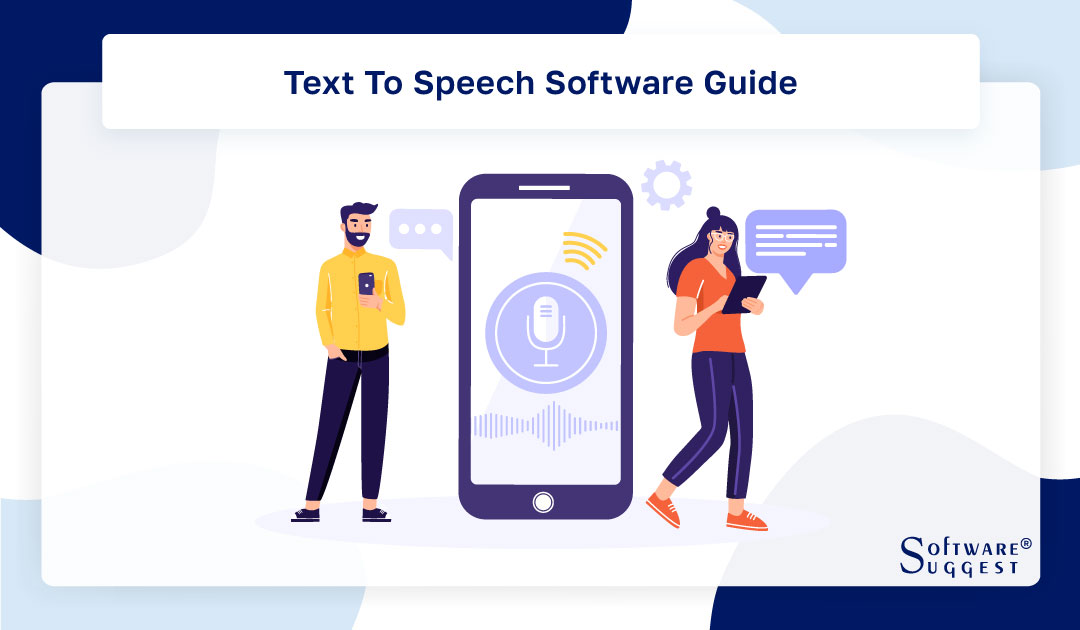
Whether you're a content creator, a business professional, an educator, or someone simply looking to make your digital content more accessible, TTS software can revolutionize the way you communicate with your audience. However, with a plethora of options available in the market, choosing the right text-to-speech software can be a daunting task.
What is Text-to-Speech (TTS) Software?
Text-to-speech (TTS) is a technique that translates written text into spoken words. Its purpose is to close the gap that exists between human aural perception and text-based information. After textual input—such as documents, web content, or user-generated text—is processed using text-to-speech (TTS) software, synthetic voices are used to vocalize the text in a way that sounds authentic and human.
There are numerous applications for this technology, including increasing the accessibility of digital content, facilitating the reading of printed materials for those who are blind or visually impaired, and enabling automated speech interfaces in a range of goods and services, including virtual assistants, GPS navigation devices, and audiobooks. Because text-to-speech software is adaptable to various languages, accents, and styles, it is a useful tool for enhancing accessibility and user experience on a variety of digital platforms.
What are the Types of Text-to-Speech Software?
Text to Speech (TTS) Software is a versatile technology with a variety of applications. These applications cater to different needs, including enhancing accessibility, facilitating e-learning, and integrating TTS capabilities into various software and services. Here, we explore three types of TTS software:

-
Text-to-speech API
Text-to-speech APIs are designed to provide developers with the tools and interfaces to incorporate TTS functionality into their applications or services. These APIs enable the generation of synthetic speech from text, allowing developers to customize voice options, language settings, and other parameters to suit their specific requirements.
Text-to-speech APIs find applications in a wide range of fields, including content-reading apps, chatbots, and customer service solutions. They empower developers to create engaging, voice-enabled experiences for their users.
-
E-learning Text-to-speech
E-learning text-to-speech software is tailored for educational environments, providing a valuable tool for enhancing the learning experience. In e-learning platforms and applications, TTS technology can convert written course content, instructions, or study materials into audio format.
This feature benefits a diverse audience, including students with visual impairments, those who prefer auditory learning, and non-native speakers seeking pronunciation guidance. E-learning TTS software facilitates inclusivity and improves engagement in online educational settings.
-
Accessibility Text to Speech
Accessibility text-to-speech software primarily focuses on making digital content more inclusive and accessible to individuals with disabilities, particularly those with visual impairments. This software can be integrated into websites, documents, and applications to read aloud text-based information, making it accessible to users who rely on auditory input.
It aids individuals in navigating websites, reading e-books, and interacting with various digital interfaces. Accessibility TTS plays a vital role in ensuring that everyone can access and benefit from online information and services in compliance with accessibility standards and regulations.
Who are the Users of Text to Voice Software?
Text-to-Voice Software, often referred to as Text-to-Speech (TTS) software, serves a diverse range of users across various industries. These users leverage TTS technology to enhance accessibility, improve user experiences, and streamline their work. Here, we explore three key user groups -
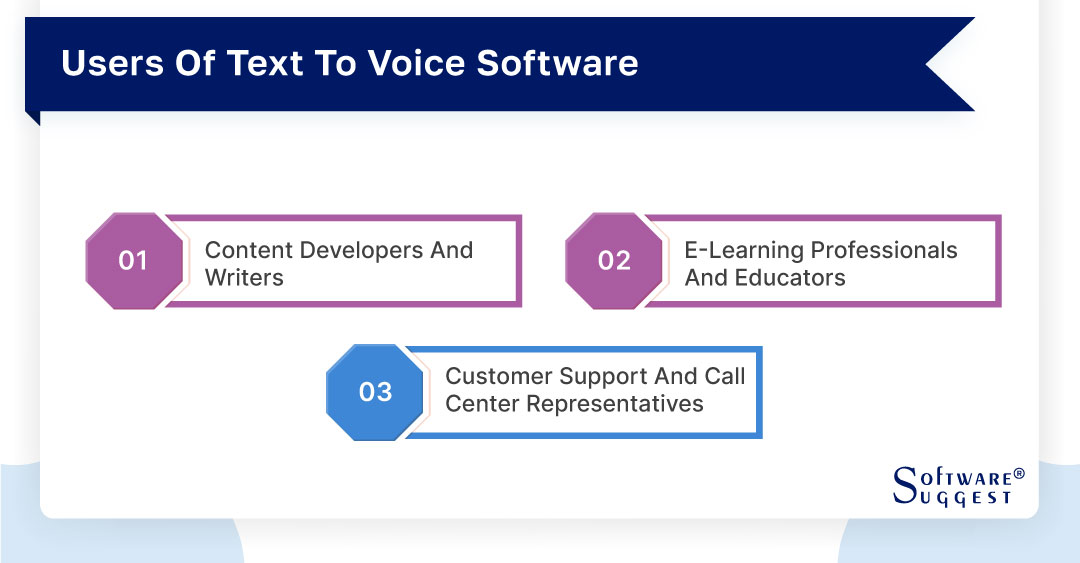
-
Content Developers and Writers
Content developers and writers are among the primary users of TTS software. They employ this technology to proofread and edit their written content. TTS tools can read aloud the text, allowing writers to identify errors, awkward phrasing, and inconsistencies that may go unnoticed when reviewing text visually.
Additionally, content developers use TTS to convert written content, such as articles, reports, and marketing materials, into audio format, making it accessible to a broader audience. TTS helps writers and content creators ensure the quality and accessibility of their work.
-
E-learning Professionals and Educators
E-learning professionals and educators are increasingly integrating the best text-to-speech programs into online learning platforms and educational resources. TTS tools enable the conversion of written learning materials, including textbooks, assignments, and lecture notes, into audio content.
This accessibility feature benefits students with diverse learning needs, including those with visual impairments and those who prefer auditory learning. Educators and e-learning professionals recognize the value of TTS in making educational content more inclusive and engaging, fostering a more accessible and diverse learning environment.
-
Customer Support and Call Center Representatives
Customer support and call center representatives use text-to-speech software to streamline their interactions with customers. TTS technology can convert written scripts and responses into spoken words, enhancing the efficiency of customer interactions.
Automated voice prompts and responses enable faster and more consistent communication with callers. Additionally, TTS can be valuable for multilingual support, as it can deliver information in multiple languages with natural-sounding voices, ensuring a seamless experience for customers.
What are the Benefits of the Best Text-to-Speech Software?
The Best text-reading Software is a powerful tool that offers a multitude of benefits across various applications. From enhancing accessibility to improving engagement and efficiency, it plays a pivotal role in modern digital environments. Here, we explore five key benefits of the best text-to-speech software:
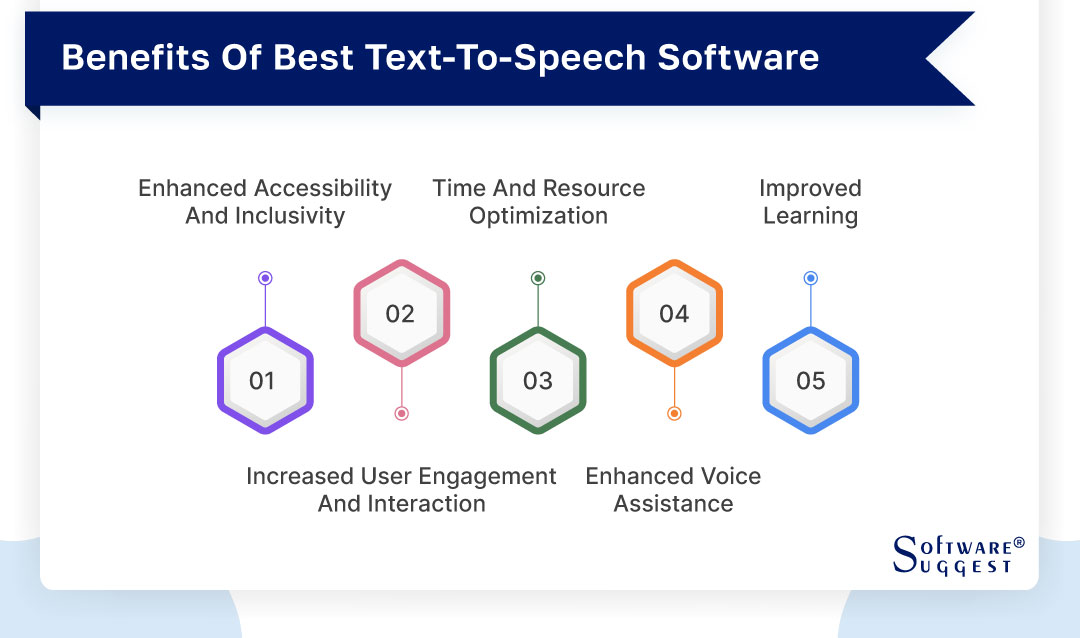
-
Enhanced Accessibility and Inclusivity
The best text-to-speech software significantly enhances accessibility by converting written content into spoken words. This feature ensures that individuals with visual impairments can access and comprehend text-based information, promoting inclusivity. Additionally, it aids non-native speakers, people with reading difficulties, and those who prefer auditory learning, making digital content more accessible to a diverse audience.
-
Increased User Engagement and Interaction
Text-to-sound software has a positive impact on user engagement by offering a more dynamic and interactive experience. In e-learning platforms, websites, and mobile apps, TTS can convert written content into audio, which is especially beneficial for educational materials, articles, or website content. Users can listen to content while on the go, improving comprehension and retention. This leads to higher user satisfaction and engagement, benefiting both content providers and consumers.
-
Time and Resource Optimization
Text-to-speech software optimizes time and resources, particularly in scenarios where extensive reading or data entry is required. It can read out lengthy documents, reports, and emails, enabling users to multitask or absorb information more efficiently. Moreover, it reduces the need for manual data entry, enhancing productivity and minimizing the risk of errors in data processing tasks.
-
Enhanced Voice Assistance
Text-to-speech software is the foundation of voice assistants and chatbots, contributing to the rise of voice-activated technologies. The best TTS solutions provide natural-sounding voices and facilitate more human-like interactions, improving the user experience with voice-enabled applications. Whether it's a virtual assistant guiding users through tasks or providing information, TTS enhances the quality of voice assistance.
-
Improved Learning
In educational settings, the best TTS software supports improved learning outcomes. It assists students by converting textbooks, lectures, and study materials into audio formats, accommodating various learning preferences. This feature aids in information retention, language learning, and a better understanding of complex subjects. TTS promotes interactive and accessible learning, making it a valuable asset for educators and learners alike.
What are the Features of the Best TTS Software?
The Best Text to Speech (TTS) Software is a versatile tool that offers a wide range of features to meet diverse user needs. Whether enhancing accessibility, enabling natural voice interactions, or streamlining content creation, these features play a pivotal role in making text-to-speech software powerful and adaptable. Here, we explore eight essential features of the best TTS software -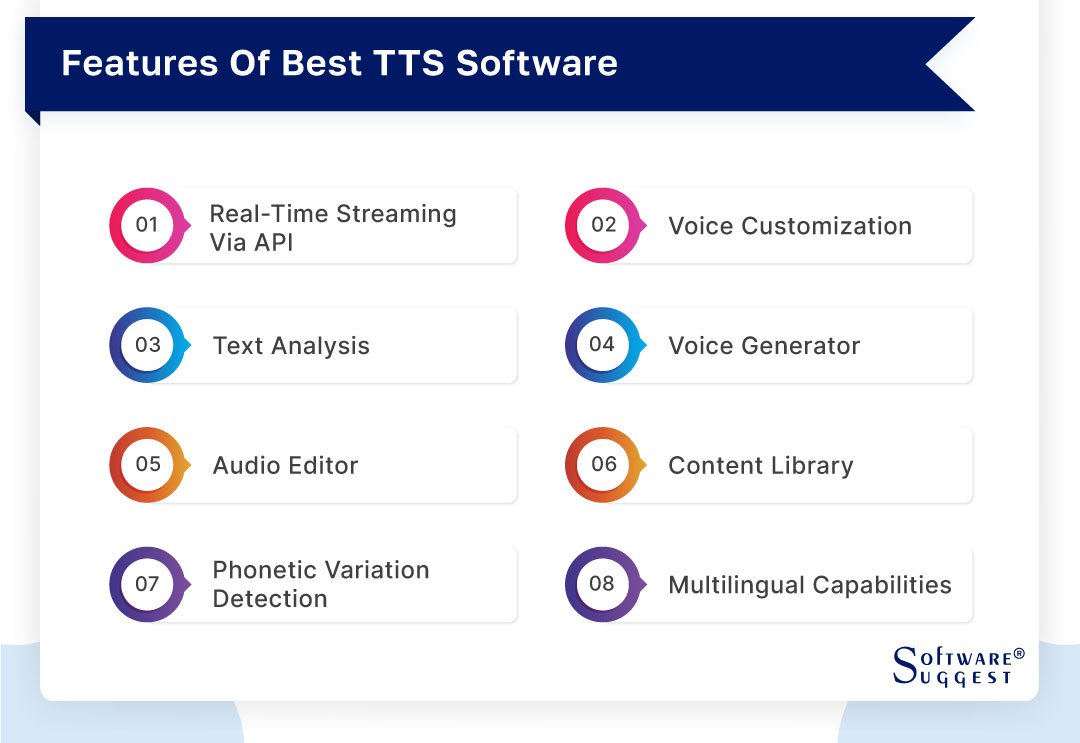
-
Real-time Streaming via API
Real-time streaming through Application Programming Interfaces (APIs) allows developers to integrate TTS into their applications or services. This feature enables on-the-fly text-to-speech conversion, making it suitable for chatbots, voice assistants, and accessibility tools, providing users with instant spoken content.
-
Voice Customization
The ability to customize voices is a key feature. The best text-to-voice software offers various voices with different tones, accents, and languages. Voice customization allows users to select a voice that aligns with the desired context, making interactions more engaging and tailored to the audience.
-
Text Analysis
Text analysis features assist in identifying and adapting to specific textual nuances. The best text-to-speech software can analyze text to detect punctuation, sentence structures, and abbreviations, helping the generated speech sound more natural and context-aware.
-
Voice Generator
A core component, the voice generator, is responsible for converting text into spoken words. It uses synthetic voices to produce natural and clear audio that can be customized to suit various applications and user preferences.
-
Audio Editor
An audio editor is a valuable feature for refining generated audio. It enables users to edit, manipulate, or enhance the output audio, allowing for the removal of errors, pauses, or background noise. This feature is essential for achieving high-quality audio content.
-
Content Library
A content library provides a repository of pre-recorded or commonly used phrases, words, or sentences. Users can access this library to include frequently used content in their TTS applications, saving time and effort in content creation.
-
Phonetic Variation Detection
The capability to detect phonetic variations is crucial for maintaining speech accuracy and quality. This feature ensures that pronunciation remains consistent and intelligible, even for words with different regional accents or pronunciations.
-
Multilingual Capabilities
Multilingual support is essential for catering to diverse audiences. The best text-to-speech software offers the ability to convert text into speech in multiple languages, making it suitable for global applications, including translation services, international business, and language learning platforms.
How to Choose the Right Text-to-Speech Software?
Choosing the right Text-to-Speech (TTS) software is essential to ensure that your specific needs and preferences are met. To make an informed decision, consider several critical factors. Here, we delve into four key considerations when selecting the right text-to-speech software:
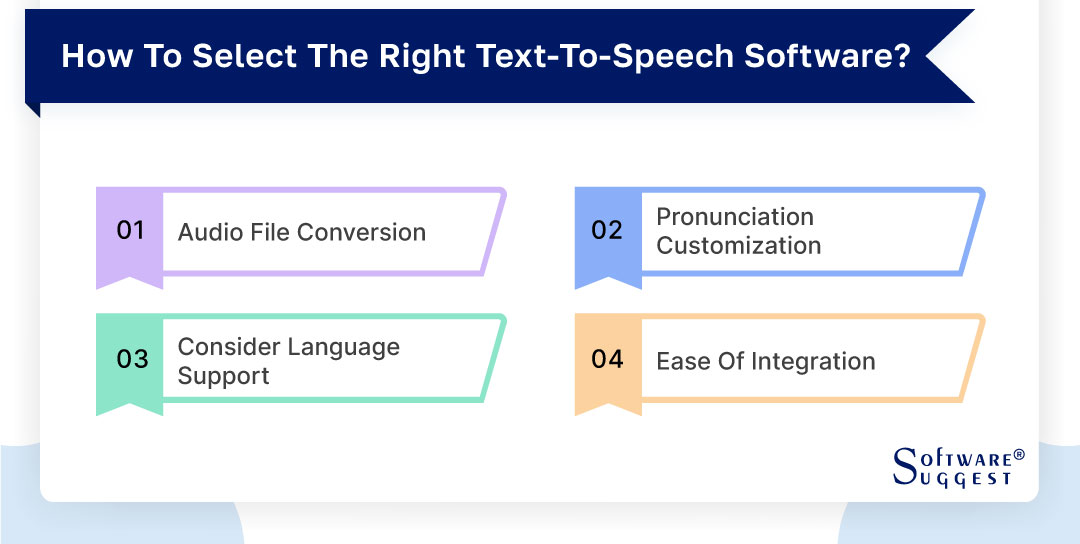
-
Audio File Conversion
One of the essential aspects to evaluate in TTS software is its capability for audio file conversion. Ensure that the software allows you to easily convert text-based content into high-quality audio files. Look for formats supported by the software and assess the audio quality. Text-to-speech software should produce clear and natural-sounding audio that aligns with your content's purpose, whether it's for accessibility, e-learning, or any other application.
-
Pronunciation Customization
Pronunciation customization is vital for adapting text-to-audio programs to your specific needs. Evaluate whether the software allows you to fine-tune the pronunciation of words, phrases, or names. This feature is particularly crucial if your content includes technical terms, industry-specific jargon, or names that may not be pronounced accurately by default. Pronunciation customization ensures that your TTS output remains accurate and context-aware.
-
Consider Language Support
Language support is a crucial factor when choosing TTS software, especially if you need multilingual capabilities. Assess the languages the software supports and the quality of the voices available for each language. The ability to seamlessly switch between languages and voices is important, particularly if you have a global or diverse audience.
-
Ease of Integration
Ease of integration is another significant consideration. Evaluate how well the text-to-speech software can be integrated into your existing applications, websites, or services. Check for compatibility with popular programming languages and platforms. User-friendly APIs and documentation are key indicators of a software's integration ease. A smooth integration process ensures that you can seamlessly implement TTS features where they are needed without unnecessary complexities.
What are the Challenges Faced in Text-to-Voice Software?
Text-to-voice software (TTS) offers valuable capabilities, but it also faces several challenges that can impact the quality and user experience. Understanding these challenges is essential for both users and developers. Here, we explore three key challenges faced in Text-to-Voice Software -
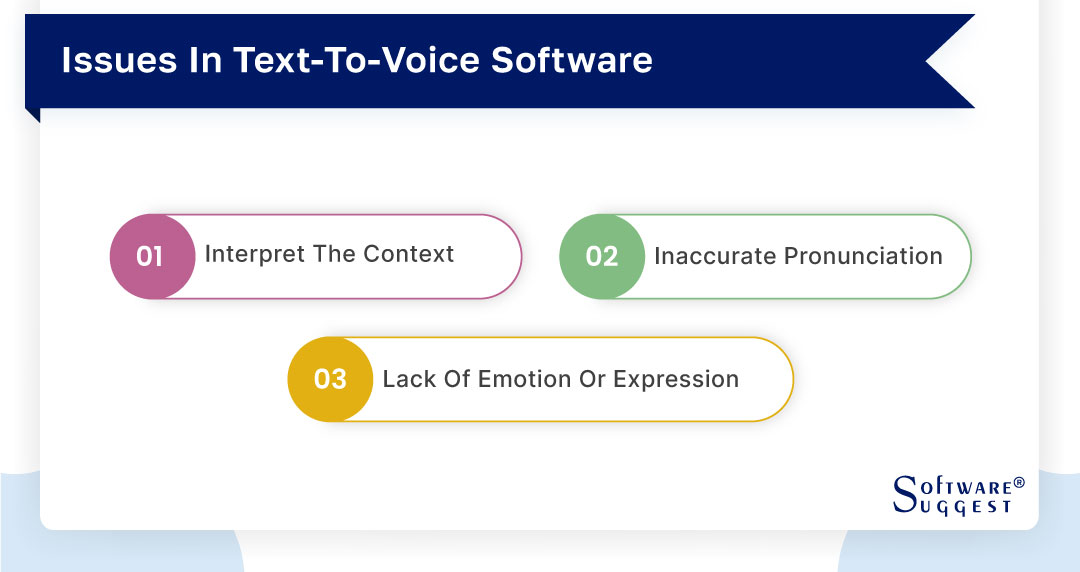
-
Interpret the Context
One significant challenge in TTS software is the ability to accurately interpret the context of the text being converted to speech. Language is rich in nuance and ambiguity, and the intended meaning of a word or phrase can change based on the surrounding content.
Text-to-speech software sometimes struggles to discern the correct pronunciation or emphasis of a word, especially when faced with homographs (words spelled the same but with different meanings) or homophones (words pronounced the same but with different meanings). This challenge can lead to misinterpretations, potentially altering the intended message and causing confusion for the end user.
-
Inaccurate Pronunciation
Achieving precise pronunciation of words is a perpetual challenge in TTS software. While TTS engines have improved in generating natural-sounding voices, they may still mispronounce words, especially technical terms, proper nouns, or words with multiple pronunciations.
Users often need to provide pronunciation guidance or manually adjust pronunciation, which can be time-consuming and frustrating. Inaccurate pronunciation hinders the effectiveness of TTS in contexts where pronunciation precision is vital, such as educational content, medical documents, or international business communications.
-
Lack of Emotion or Expression
Another challenge in text-to-speech software is the ability to convey emotion or expression in the spoken text. Human speech is not just about words but also about tone, pitch, and emotional nuance. Text-to-speech software can often sound monotonous or lack the emotional depth that a human voice naturally carries.
This limitation impacts the user experience, particularly in applications where conveying emotion or engaging the audience is essential, such as storytelling, customer service, or interactive virtual assistants. Overcoming this challenge and achieving expressive speech remains an ongoing area of development in TTS technology.
Software Related to TTS Software
Text-to-speech (TTS) Software is often integrated with a variety of other software tools to create a seamless and versatile user experience. These related software solutions enhance the capabilities of TTS and extend its applications. Here, we explore three key types of software related to TTS:
-
Natural Language Processing (NLP) Software
NLP software is closely related to TTS technology. NLP tools enable the analysis and understanding of human language, allowing TTS software to convert text into spoken words with greater context and accuracy. NLP assists in interpreting the meaning, sentiment, and intent behind the text, which is valuable for generating more natural-sounding and context-aware voice content.
By integrating NLP with TTS, developers can create interactive voice interfaces, chatbots, and virtual assistants that understand and respond to user queries in a more human-like manner.
-
Translation Management Software
Translation management software is another important companion to TTS technology, especially in multilingual contexts. Text-to-speech software can convert text to speech in various languages, but translation management software plays a crucial role in ensuring the quality and accuracy of translations.
When TTS is used to render content in multiple languages, translation management software helps in the localization process by providing tools for human or machine translation, terminology management, and quality control. This synergy ensures that TTS-generated content is not only multilingual but also culturally and contextually appropriate.
-
Content Management Systems
Content Management Systems (CMS) play a pivotal role in organizing and delivering content, which is often later converted to speech by TTS software. CMS platforms allow businesses and content creators to manage, edit, and structure text-based content.
Integration with TTS simplifies the process of transforming text content into audio files for various applications, such as podcasts, audiobooks, and interactive content. By connecting CMS with TTS, organizations can offer a more diverse and accessible range of content delivery options to their audience.
Market Trends in Text-to-Speech Software
Text to Speech (TTS) Software is continuously evolving, driven by technological advancements and changing user expectations. Staying informed about the latest market trends in TTS is essential for both developers and users. Here, we explore four significant market trends in Text to Speech Software
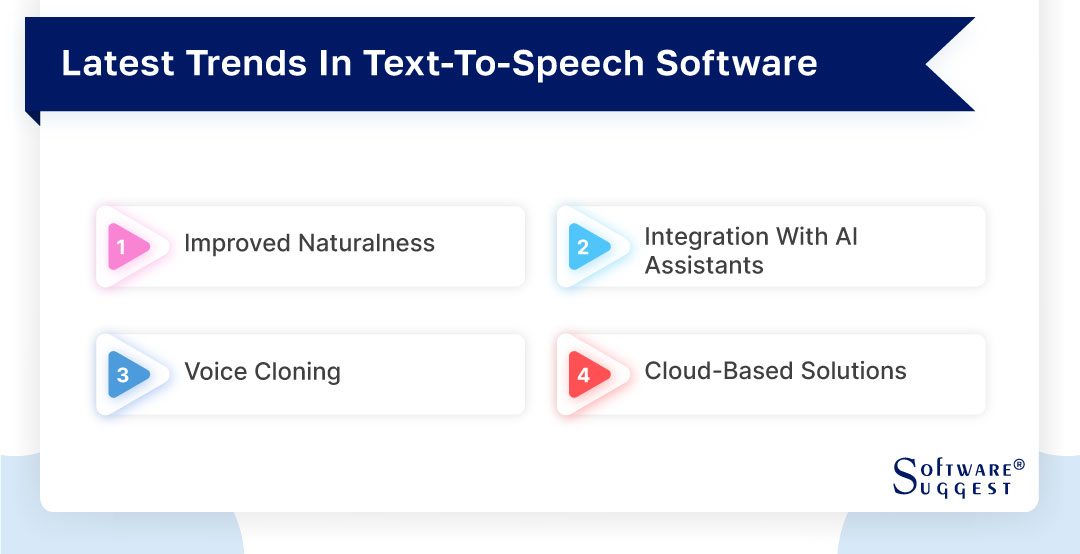
-
Improved Naturalness
Enhanced naturalness in TTS voices is a prominent trend in the market. The goal is to make synthesized speech sound as close to human speech as possible. With advancements in neural TTS models, TTS voices are becoming more expressive, with nuanced intonation, prosody, and emotion.
This trend is pivotal in applications where conveying emotion or engagement, such as virtual assistants, customer service, and audiobooks, is paramount. Improved naturalness in TTS voices contributes to more immersive and enjoyable user experiences.
-
Integration with AI Assistants
Integration of TTS with AI assistants is a growing trend. TTS technology is a foundational component of virtual assistants like Siri, Alexa, and Google Assistant. These assistants rely on TTS to communicate with users through voice interactions.
With TTS, these assistants offer seamless and human-like responses, enhancing their utility and making them more accessible to users. The integration of TTS with AI assistants is expanding into various applications, from smart home devices to customer service chatbots.
-
Voice Cloning
Voice cloning is an emerging trend in TTS, offering users the ability to create custom TTS voices. By training TTS systems with a person's voice, it's possible to generate speech that sounds like that individual.
This technology finds applications in personalized voice assistants, audiobooks narrated by favorite voices, and accessibility solutions where users can have content read to them in a familiar voice. Voice cloning is evolving rapidly and has the potential to redefine the concept of voice personalization.
-
Cloud-Based Solutions
Cloud-based TTS solutions are gaining prominence, offering flexibility and scalability. Cloud-based TTS enables developers to access TTS resources and services on-demand, making it easier to integrate TTS into applications and services without the need for extensive on-premises infrastructure. It also facilitates real-time TTS generation via APIs and supports applications like automated transcription, customer service, and voice-enabled content in a cost-effective manner.
Conclusion
Text to Speech (TTS) Software is a dynamic and versatile technology that continues to play a pivotal role in making digital content more accessible, engaging, and interactive. From enhanced naturalness in synthesized voices to seamless integration with AI assistants, TTS has evolved to meet the ever-changing needs of users and industries. Voice cloning and cloud-based solutions are emerging as transformative trends, offering personalized and scalable TTS experiences.
FAQs
The cost of text-to-speech (TTS) software can vary widely depending on several factors. Some text to speech software options are available for free or as open-source solutions, making them cost-effective choices for individuals, small businesses, or educational purposes.
Commercial TTS software, on the other hand, often involves licensing fees that can range from $55 to $1400, depending on factors such as the number of voices available, the quality of voice options, and the scope of usage. Additionally, cloud-based TTS services, offered by companies like Amazon, Google, and Microsoft, follow a pay-as-you-go model, where users are charged based on the volume of text they convert to speech.
The responsibility for text-to-speech (TTS) software implementation can vary depending on the specific context and use case. In general, it involves a combination of different roles and responsibilities
-
Software Developers
-
Content Creators
-
User Experience (UX) Designers
-
Quality Assurance (QA) Testers
-
System Administrators
-
Accessibility Experts
-
Project Managers
Some TTS providers known for offering realistic voices and advanced TTS technologies include:
-
Google Text-to-Speech (GPT-3 and WaveNet)
-
Amazon Polly
-
IBM Watson Text to Speech
-
Nuance Communications (now part of Microsoft)
-
ReadSpeaker
























